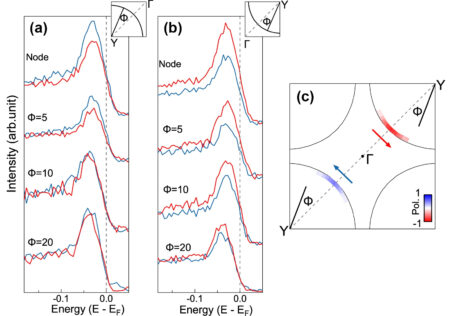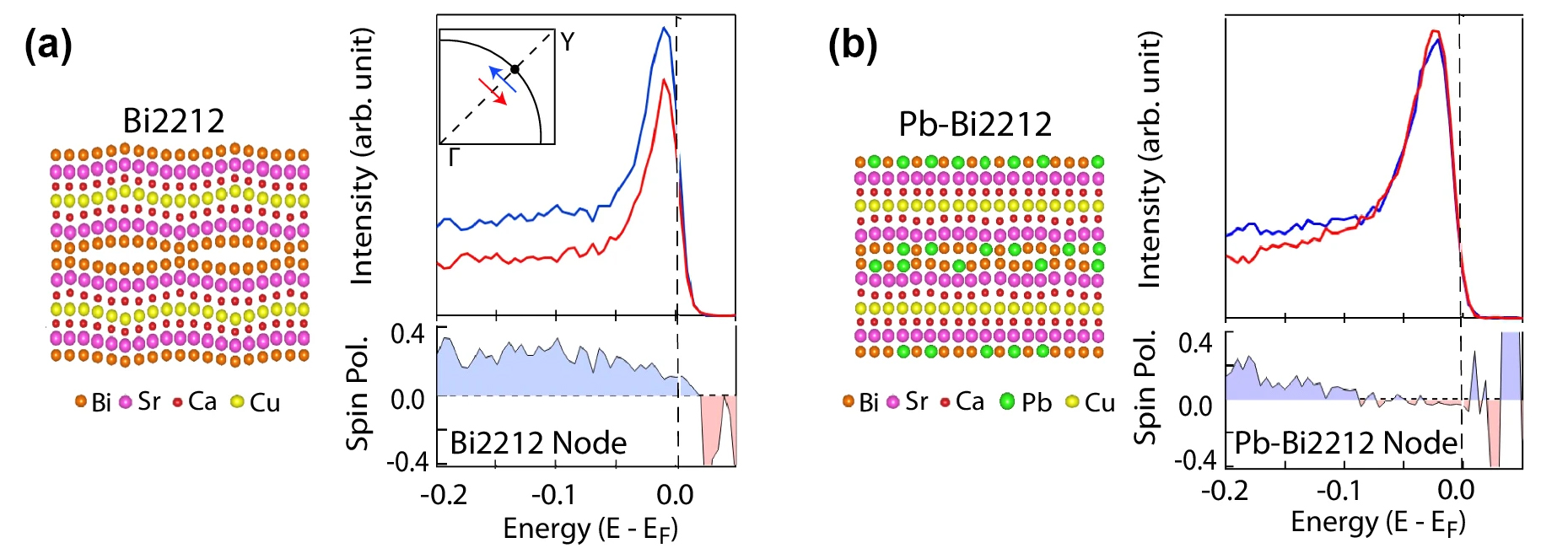SCIENTIFIC ACHIEVEMENT
With the help of the Advanced Light Source (ALS), researchers found that in bismuth-based cuprate superconductors, charge imbalances caused by lattice distortions generate persistent and universal patterns of spin polarization.
SIGNIFICANCE AND IMPACT
The results supply a previously missing but essential ingredient in efforts to understand the mechanisms driving the electronic behavior of high-temperature superconductors.

A crucial clue to cuprates
Copper oxide (cuprate) superconductors have attracted tremendous interest because of their potential for resistance-free conduction in electromagnets, generators, power-transmission lines, and energy-storage applications. However, elusive questions still remain regarding the mechanisms driving the electronic behavior of these high-temperature superconductors. Spin-orbit coupling—an important property shaping many exotic phenomena of quantum materials—has long been neglected in studies of cuprate superconductors.
In this work, researchers uncovered electron spin textures (patterns in a material’s spin polarization) in several forms of bismuth-based cuprates across a wide doping range, using spin- and angle-resolved spectroscopy. The findings suggest that the observed spin textures are the result of local distortions in the lattice, which produce non-negligible spin–orbit coupling. The work raises the intriguing possibility that the interplay between spin-orbit coupling and lattice symmetry might constitute a heretofore missing ingredient in our understanding of cuprate physics.
A nontrivial spin texture
Spin-orbit coupling (interactions between an electron’s spin and its orbital motion) has long been considered negligible in cuprate superconductors. However, a previous study from the researchers revealed a nontrivial spin texture, attributed to spin-orbit coupling, in one of the most-studied bismuth-based cuprate superconductors, Bi2Sr2CaCu2O8+x (Bi2212).
To investigate the evolution of the spin texture upon different doping levels and to determine the source of the spin-orbit coupling, the researchers mapped the spin textures of Bi2212 samples that were overdoped (with holes), underdoped, and optimally doped, as well as that of Bi2Sr2CuO6+x (Bi2201) and lead-doped (Bi2-xPbx)Sr2CaCu2O8+x (Pb-Bi2212). To make these observations, they conducted spin- and angle-resolved photoemission spectroscopy (spin-ARPES) using the ALS and a lab-based (laser) source.
Spin-resolved ARPES
The work was made possible in part by a new spin-resolved ARPES instrument recently developed at ALS Beamline 10.0.1. It is equipped with 3D very-low-energy electron diffraction (VLEED) spin detectors, enabling the collection of electrons with different spin components. In addition, the beamline’s photon energy can be tuned over a much larger scale than a laser, allowing the researchers to choose the energy providing the sharpest band structures and to probe a much larger momentum space at once. With this development, the ALS joins an elite group of European and Japanese synchrotrons supporting spin-resolved ARPES.
The ALS data revealed how the spin component reverses direction across the Brillouin zone center (Γ), pointing to a spin polarization that is not only a function of momentum, but that also respects time-reversal symmetry (by switching sign across the Γ point).

In the Pb-Bi2212 samples, the partial substitution of Pb for Bi suppressed local lattice fluctuations, reducing the spin polarization. This is consistent with the researchers’ proposed model where the spin asymmetry is driven by charge imbalances caused by the local lattice modulation. Overall, the results demonstrated the universality of the spin polarization for various doping levels and the disappearance of spin polarization upon the suppression of local lattice fluctuations. In the future, the team plans to investigate more classes of cuprate superconductors to explore the extent of the universality of this spin texture driven by spin-orbit coupling.

Contact: Hailan Luo
Researchers: H. Luo, K. Currier, C.-Y. Lin, K. Gotlieb, and A. Lanzara (UC Berkeley and Berkeley Lab); R. Mori (Berkeley Lab); H. Eisaki (National Institute of Advanced Industrial Science and Technology, Japan); and A. Fedorov and Z. Hussain (ALS).
Funding: US Department of Energy, Office of Science, Basic Energy Sciences program (DOE BES), Materials Sciences and Engineering Division. Operation of the ALS is supported by DOE BES.
Publication: H. Luo, K. Currier, C.-Y. Lin, K. Gotlieb, R. Mori, H. Eisaki, A. Fedorov, Z. Hussain, and A. Lanzara, “Doping dependence of spin-momentum locking in bismuth-based high temperature cuprate superconductors,” Commun. Mater. 5, 140 (2024), doi:10.1038/s43246-024-00567-4.
ALS SCIENCE HIGHLIGHT #513